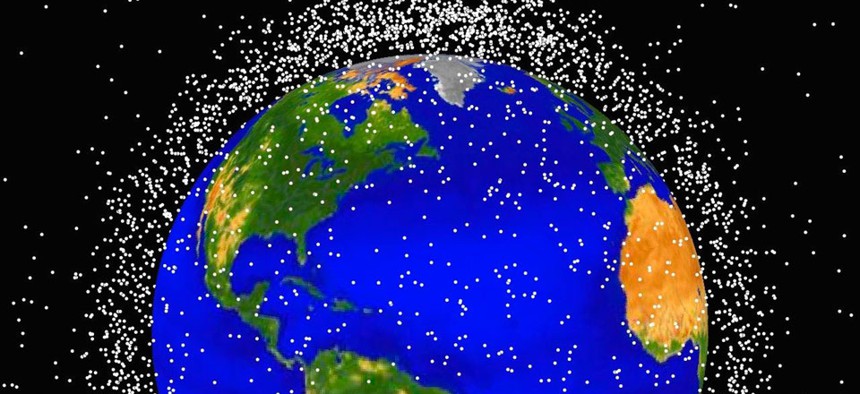Accumulating Space Debris Threatens Satellites

This computer generated graphic provided by NASA shows images of objects in Earth orbit that are currently being tracked. NASA/AP
Orbital trash is making it harder to leave Earth and causing headaches and danger for the astronauts and equipment already in space.
No one really knows what an outer-space garbageman would look like. Nor does anyone want to find out. But our gradual accumulation of orbital trash is giving us narrower and narrower windows from which to leave the Earth—and causing headaches and danger for the astronauts and equipment already in orbit.
In space, there are no tow trucks to clear disabled equipment. And derelict hunks of metal don't sit by the side of the road—they hurtle around at 17,000 mph. At that speed, even a golf ball-sized object has the potential to take out a satellite system.
The Air Force currently tracks about 23,000 pieces of space debris. Its radar can see an object the size of a basketball about 15 miles away. But there are about half a million more debris bits it can't see. That has raised fears about the Kessler syndrome, a scenario put forth by a NASA scientist in the 1970s in which space becomes so overpopulated that collisions set off bigger and bigger chain reactions, making it nearly impossible to navigate.
"I don't think people realize how much we depend on satellites," said Paul Ceruzzi, a researcher at the National Air and Space Museum. "Our lives really would come to a halt if these satellites stopped working." Fortunately, he added, "the odds of more than one collision happening independently is pretty remote at the moment."
Thanks to trash-trackers like the Air Force and NASA, we've been able to mostly avoid whizzing space junk so far. "[Debris is] not threatening to the human exploration of space—yet," Ceruzzi said. But avoiding it hasn't come without difficulty. The International Space Station has had to take evasive maneuvers 16 times in its 15 years in orbit. And it's only going to get trickier.
Though space-capable countries have gotten more responsible about disposing of their trash, 10 percent of rocket upper stages and 40 percent of satellites still get left in orbit after they've outlived their usefulness. "There's already enough out there to keep debris multiplying on its own accord," said Greg Allen, an analyst for aerospace consulting group Avascent. "But there's not enough out there to keep space from being usable."
That could change if we don't stop disposing of metal in the sky—or if a couple of larger objects collide, creating a debris field that could impact even more objects. And while the trash pile gradually grows, we don't have a plan to start uncluttering the sky.
"There's really no getting rid of the debris that's already up there," Allen said, citing the prohibitive cost of launching missions to get rid of each object. "The way to think of space is not in distance.... Those 250 miles are in reality over $100 million away.... There's no coming down. That stuff's there."
That doesn't mean there haven't been attempts to bring it down. Japan is about to test a 700-meter magnetic net designed to haul in some debris, but many are skeptical about its ability. It's not propellant-powered, so it moves very slowly. Its magnets won't work on the many satellites made of nonferrous metals. There's also concern that the fast-moving objects could snap the net's tether, generating even more debris.
Others have proposed using ground-based lasers to redirect some objects. "People have ideas about how to do garbage collection up in space, but nothing has really emerged yet as a practical thing to do," Ceruzzi said.
Any plan to get rid of space debris, Allen said, would have to focus on the big objects—satellites and rocket stages—that could serve as debris-field multipliers if they were to collide with another object. But there are already 1,350 such objects in geostationary orbit alone, with many more in low-Earth orbit. And only 30 percent of them still respond to ground-based control. Given the sheer volume of the objects we'd need to bring down—and the fact that each mission would cost hundreds of millions of dollars—well, it adds up fast.
"It's very expensive to get payloads into space," Ceruzzi said. "Who would pay? ... One nation would have to take the initiative to pay." It's not likely to be the U.S., where congressional budget cuts have already cut NASA's cash flow.
Debris retrieval would also raise all sorts of tricky international questions. Who's responsible for what's already up there? What about all the objects left by the now-defunct Soviet Union? Can litterers be made to pay for other countries' cleanup? Those headache-inducing problems aren't likely to be resolved in the near future.
So if we can't get rid of this debris anytime soon, we must be redoubling our efforts to track it, right? Wrong again. Thanks to sequestration, last summer the Air Force had to cut its "Space Fence" program, responsible for about 40 percent of tracking on its Space Surveillance Network. Though there have been no collisions since the cut, "we've been lucky," Allen said.
For now, scientists are resigned to doing the little they can to keep space safe. That means tracking debris as much as possible and encouraging spacefaring countries to be responsible. Low-orbit satellites need to be guided into reentry—preferably over the ocean—at the end of their life span. Geostationary satellites in higher orbit need to be fitted with thrusters to boost them up out of the way when they've outlived their usefulness.
"Good behavior ... is getting better over time," Allen said. "It's surprisingly not as good as you might think." Still, there's at least a little optimism that the imminent danger will cause countries to change their ways. "Every nation that attains the capability of putting stuff into space recognizes the responsibility," Ceruzzi said.
NEXT STORY: A More Social State of the Union





